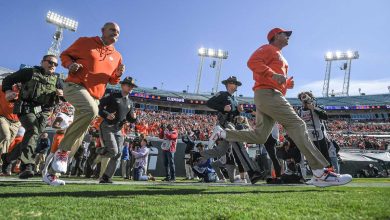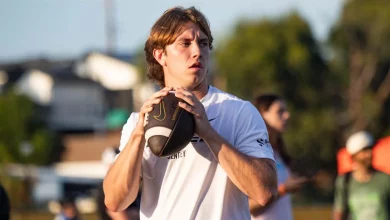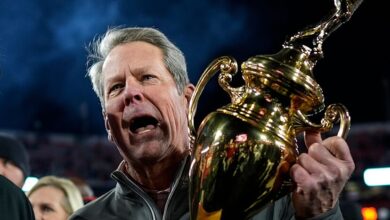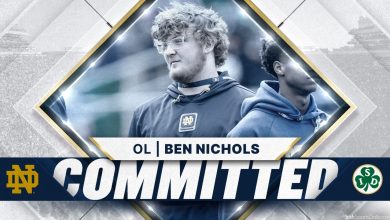Oregon files a lawsuit against 4running backs coach Carlos Locklyn, seemingly frustrated after losing him—and a key recruiting battle—to the Buckeyes.

In a stunning and highly unusual turn of events, the University of Oregon has filed a lawsuit against Ohio State running backs coach Carlos Locklyn, alleging breach of contract and improper recruiting practices following his departure from the Ducks to join the Buckeyes.
The move has rocked the college football landscape, not just for its legal implications, but for what it represents—a growing tension in the high-stakes world of coaching turnover, elite recruiting, and conference power struggles. At the center of it all stands Carlos Locklyn, a respected coach with a reputation for building elite backfields and forging strong ties with top talent. But now, he’s being dragged into court instead of the College Football Playoff.
Is this simply sour grapes from a program that lost a valued coach to a Big Ten rival? Or is there more beneath the surface?
The Coaching Carousel Spins—and Backfires
Carlos Locklyn’s move from Oregon to Ohio State raised eyebrows when it was announced earlier this offseason. Known for his dynamic energy on the recruiting trail and his developmental work with Oregon’s backfield, Locklyn was widely regarded as one of the top assistants in the Pac-12. His sudden switch to Ohio State—a team Oregon will face regularly now that the Ducks have joined the Big Ten—sparked rumors and speculation, but no one expected a lawsuit to follow.
According to court documents, Oregon alleges that Locklyn violated terms of his contract, including recruiting-related non-compete clauses and notification obligations. The Ducks argue that Locklyn began communicating with Ohio State representatives before formally informing Oregon of his intent to leave—allegedly poaching key recruiting targets in the process.
A university spokesperson for Oregon stated:
“We are committed to maintaining the integrity of our football program and the recruiting process. We believe in holding individuals accountable when contractual agreements are violated.”
Locklyn’s Impact—and Departure
Locklyn joined Oregon in 2022 and immediately made his presence felt. He helped revitalize the Ducks’ running game and played a crucial role in landing several four- and five-star recruits. His enthusiasm, authenticity, and hands-on coaching style made him a favorite among players and families alike.
But just two seasons into his tenure, Locklyn was on the move again. His arrival in Columbus was met with excitement, particularly as Ohio State looks to re-establish its ground game and retool its offense after back-to-back losses to Michigan and postseason heartbreaks.
What rankled Oregon most wasn’t just the loss of Locklyn—but who he took with him. Multiple top-tier running back recruits decommitted from Oregon shortly after his departure. Some have since committed to or visited Ohio State, prompting the Ducks to cry foul.
Legal Stakes: Can You Really Sue Over a Coach Leaving?
College football has long been a Wild West of coaching movement. Assistants and coordinators routinely change jobs, often under tight timelines and with little public transparency. So what makes this situation different?
According to legal analysts, the strength of Oregon’s case rests on a few key questions:
- Did Locklyn break any written terms in his contract? If Oregon can prove he actively recruited players on behalf of Ohio State before exiting his position, it may constitute a breach.
- Was there a clause barring recruitment overlap or requiring notice? Some contracts have clauses mandating a certain buffer period before a coach can contact recruits or staff from their previous school.
- Can damages be proven? Oregon would need to show that Locklyn’s actions caused measurable harm—such as loss of recruits or financial damage to the program.
Still, even with contractual clauses, legal experts note that these cases are notoriously difficult to win. Many colleges prefer to settle such disputes behind closed doors rather than risk exposing internal documents, recruiting strategies, or staff correspondence in court.
What This Says About the State of College Football
Lawsuits over coaching moves are rare—but not unheard of. What’s striking here is how public and bitter this dispute has become. It reflects the increasingly competitive nature of college football, where coaching hires and player commitments are multimillion-dollar decisions.
With the arrival of NIL deals, the transfer portal, and conference realignment, every edge matters. Locklyn’s transition to Ohio State didn’t just take a coach off Oregon’s staff—it may have altered the recruiting landscape in both conferences.
And as the Big Ten prepares for its first season with West Coast powerhouses like Oregon and USC, the stakes are higher than ever. This lawsuit could be seen as a warning shot: Poach our staff, and we’ll fight back.
The Human Side: What This Means for Locklyn
For Locklyn, the lawsuit represents an unexpected and unwanted distraction. He released a brief statement through his legal team:
“I’ve always conducted myself with integrity and professionalism. I am confident the facts will show I acted appropriately throughout this process. My focus remains on developing young men and preparing for the season ahead.”
Colleagues from both Oregon and Ohio State have largely stayed silent, but sources close to Locklyn say he was “blindsided” by the legal action and maintains he followed standard protocols.
The Buckeyes have expressed support for Locklyn and are reportedly assisting with legal resources as the matter unfolds.
Recruiting Fallout: High-Stakes and High Emotions
Beyond the legal drama, the recruiting trail is already feeling the ripple effects. Several recruits and their families have been dragged into the controversy—caught between two powerhouse programs now embroiled in a public spat.
High school coaches across the West Coast have privately expressed concern that the lawsuit could lead to a chilling effect on communication and transparency between programs and recruits.
“It’s already a mess with NIL and the portal,” one coach told us anonymously. “Now we have to worry about lawsuits when a coach leaves? It’s crazy.”
For Oregon, the priority is damage control—both in salvaging its 2025 class and in reinforcing its commitment to stability amid transition.
Conference Implications: Big Ten Battle Lines Drawn
With Oregon now a member of the Big Ten, the tensions with Ohio State are even more pronounced. The Ducks and Buckeyes could very well meet in a conference championship setting, and the rivalry could blossom quickly given this offseason drama.
Don’t be surprised if the Oregon–Ohio State matchup becomes one of the most anticipated and emotional games of the 2025 season. Fans already eager for new rivalries in a realigned college football world now have even more fuel for the fire.
The Bigger Question: Is This the New Normal?
What does it say about college football when coaching transitions are met with lawsuits? Perhaps it’s a sign of the growing corporatization of the sport, where every staff hire and recruiting win is treated like a high-stakes business deal.
In the NIL era, talent is more mobile, loyalty is more fluid, and stakes are higher than ever. Universities are investing millions—not just in facilities, but in coaching staffs, legal teams, and marketing strategies to maintain their edge.
And with real money on the line, disputes like this one may become more common—even if they’re not ideal for the health of the sport.
Final Thoughts: Legal Battles and Turf Wars
Carlos Locklyn may have moved from Eugene to Columbus, but the path wasn’t paved quietly. Oregon’s lawsuit against the former running backs coach is more than a legal matter—it’s a statement. One that says: “We’re not letting talent be taken without a fight.”
Whether the courts side with Oregon or Locklyn remains to be seen. But one thing is certain: The battle lines in college football are no longer just drawn on the field—they’re now being fought in courtrooms too.
And for fans, coaches, and players caught in the middle, it’s just another chapter in the unpredictable, high-drama saga that is modern college football.









